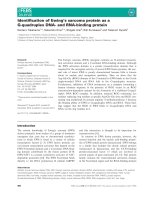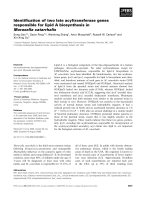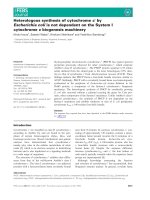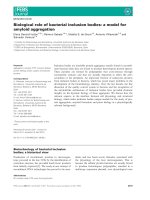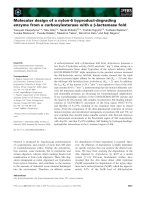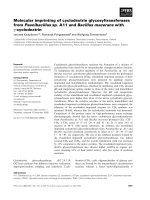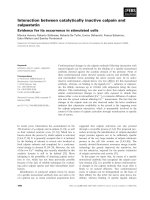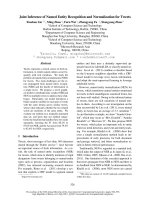Báo cáo khoa học: D88A mutant of cytochrome P450nor provides kinetic evidence for direct complex formation with electron donor NADH ppt
Bạn đang xem bản rút gọn của tài liệu. Xem và tải ngay bản đầy đủ của tài liệu tại đây (534.7 KB, 8 trang )
D88A mutant of cytochrome P450nor provides kinetic evidence for
direct complex formation with electron donor NADH
Mariko Umemura
1
, Fei Su
1
, Naoki Takaya
1
, Yoshitsugu Shiro
2
and Hirofumi Shoun
3
1
Institute of Applied Biochemistry, University of Tsukuba, Japan;
2
The Institute of Physical and Chemical Research Institute, RIKEN
Harima Institute, Mikazuki-Cho, Sayo, Japan;
3
Department of Biotechnology, Graduate School of Agricultural and Life Sciences,
The University of Tokyo, Japan
The haem-distal pocket of nitric oxide reductase cyto-
chrome P450 contains many Arg and Lys residues that are
clustered to form a putative access channel for NADH.
Asp88 is the sole negatively charged amino acid in this
positive charge cluster, and thus it would b e interesting to
know its functional r ole. Here we found the intriguing
phenomenon that mutation at this site of P450nor (D88A
or D88V) c onsiderably d ecreased t he overall nitric oxide
reductase activity without blocking the reducing half reac-
tion in which the ferric enzyme–NO complex is reduced
with NADH to yield a specific intermediate (I). The results
indicate that the catalytic turnover s ubsequent to the I
formation was blocked by such m utation. This property of
the mutants made it possible to perform kinetic a nalysis of
the reduction step, which is impossible with the wild-type
P450nor. These results a re the first kinetic evidence for
direct complex formation between P450nor and an electron
donor (NADH or N ADPH). The k inetic analysis also
showed that the inhibition by chloride ions (Cl
–
)iscom-
petitive with respect to NAD(P)H, which highlights the
importance of the binding site for Cl
–
(the anion hole) in
the interaction with NAD(P)H. We also characterized
another mutant (D393A) of P450nor. The results demon-
strated that both A sp residues p lay important roles in the
interaction with NADH, whereas the role of Asp88 is
unique in that it must be essential for the release of
NAD
+
rather than binding to NADH.
Keywords: cytochrome P450nor; P450nor; NADH.
Cytochrome P450 is the t erm used for a g roup of haem
proteins that widely exist i n life from b acteria to higher
organisms such as mammals [1,2]. P450 usually catalyses
a monooxygenase reaction, whereas its molecular and
functional diversity is so remarkable that some P450
species catalyse dehydration, isomerization, reduction,
C–C bond cleavage, and s o on [3]. P450nor is one of
such diverse P450 species and is involved in fungal
denitrification [4–6]. I t functions as a n itric oxide ( NO)
reductase (NOR) t o reduce NO t o nitrous oxide (N
2
O),
with NADH or NADPH (NAD(P)H) as the electron
donor [4]. P450nor can complete this reaction without
the aid o f other p roteinaceous components such a s P450
reductase and thus receives electrons directly from
NAD(P)H (Eqn 1).
2NO þ NAD(P)H þ H
þ
! N
2
O þ NAD(P)
þ
þ H
2
O
ð1Þ
Fe
3
þ
þ NO ! Fe
3
þ
ÀNO ð2Þ
Fe
3
þ
ÀNO þ NAD(P)H ! I þ NAD(P)
þ
ð3Þ
I þ NO ðþ H
þ
Þ!Fe
3
þ
þ N
2
O þ H
2
O ð4Þ
The overall NOR reaction can be divided into three partial
reactions [7]: first, t he resting enzyme with ferric haem (Fe
3
+
)
binds the substrate NO to form a ferric enzyme–NO complex
(Fe
3
+
–NO) (Eqn 2). Fe
3
+
–NO is then reduced by
NAD(P)H to yield a specific intermediate (I) exhibiting a
Soret absorption peak at 444 nm ( Eqn 3), and finally I reacts
with a second NO to form the product N
2
O(Eqn4).We
assume I to be the two-electron reduced product of Fe
3
+
–
NO, formally the (Fe
3
+
–NO)
2–
state [7]. Several lines of
evidence support hydride (H
–
) t ransfer from N AD(P)H to
the Fe
3
+
–NO complex to form I in Eqn 3. For example, I is
formed upon reduction of the Fe
3
+
–NO complex with
sodium borohydride, and a kinetic isotope effect has been
observed in the reduction step for the proR hydrogen of
NADH [8]. This mean s that the eq uivalent of two e lectrons
and one proton is provided by NADH. The chemical form o f
I thus depends on when the second proton is provided. I
wouldbeinthe(Fe
3
+
–NO)2H
+
)
2–
state, which is e quivalent
to a ferric-hydroxylamine radical complex, if the second
proton is also provided in the reduction step (Eqn 3) [8]. On
Correspondence to H. Shoun, Department of Biotechnology, Gradu-
ate School of Agricultural and Life Sciences, The University of Tokyo,
Bunkyo-ku, Tokyo 113-8657, Japan. Tel.:/Fax: +81 35841 5 148,
E-mail:
Abbreviations: DA, difference in absorbance; k
dec
, rate constant of
decomposition; k
obs
, observed (apparent) first order r ate constant;
k
red
, rate constant of reduction; NOR, nitric oxide reductase;
P450, cytochrome P450.
(Received 10 November 2003, revised 6 April 2004,
accepted 6 May 2004)
Eur. J. Biochem. 271, 2887–2894 (2004) Ó FEBS 2004 doi:10.1111/j.1432-1033.2004.04206.x
the other hand, however, if the second proton is provided in
the subsequent step, as indicated a bove (Eqn 4), I should be
in the ( Fe
3
+
–NOH
+
)
2–
state.
The three-dimensional structure of P450nor [9] exhibits
unique features, although overall structural similarity to
other P450s is conserved. That is, there is an open space in
the haem-distal pocket that has a hydrophilic environment
including many hydrophilic amino acid residues and water
molecules [10]. This unique feature suggests that the
P450nor molecule has become d iversifiedsoastointeract
with the hydrophilic electron donor NAD(P)H, which is
distinct from the molecular evolution of u sual monooxy-
genase P450s that generally employ hydr ophobic organic
substances as substrates. We thus expect that this big haem-
distal pocket forms an access c hannel for NAD(P)H.
We are c urrently characterizing the distal-haem pocket o f
P450nor by means of s ite-directed mutagenesis s tudies in
order t o prove the working hypothesis that t he pocket forms
an access channel for NAD(P)H. There are many Arg and
Lys residues i nside and outside the haem-pocket of P450nor.
We have shown t hat this positive charge cluster plays a
crucial role i n a ttracting a nd binding to the n egatively
charged NAD(P)H molecule [11]. We have shown also that
the specificity of P 450nor for electron donors (NADH and
NADPH) is mainly determined by a few amino a cid residues
in the B¢-helix [12]. We have further shown that s ome
NADH analogues cause a specific spectral c hange of t he
bound haem upon mixing with P450nor, indicating that
these NADH analogues can bind to P450nor [12].
The above r esults are h ighly indicative that t he reduction
step (Eqn 3) comprises two steps obeying a normal
enzymatic reaction, i.e. reversible c omplex (Michaelis inter-
mediate) formation between P450nor and NADH, and a
subsequent catalytic (ele ctron transfer) r eaction (Eqn 5 ). On
the other hand, the possibility cannot b e ruled out yet that
the electron transfer f rom NADH to P450nor is carried out
in a manner like in a chemical reaction (one-step reaction;
Eqn 6), as the reaction of P450nor is too rapid ( more than
1000 s
)1
at 10 °C) [7] for an enzymatic reaction in which
electron transfer f rom or t o NAD is involved. To discrim-
inate enzymatic and chemical r eactions, classical k inetic
analysis is still effective for determining whethe r or not the
rate of an e nzymatic r eaction is s aturated as to th e s ubstrate
concentration. However, the electron transfer from NADH
to P450nor (Eqn 3) is too rapid to be followed with a high
NADH concentration, even with a rapid reaction analyser.
Thus, such k inetic analysis has not been performed yet.
E þ NADH $ E-NADH ! I þ NAD
þ
ðE : Fe
3
þ
À NOÞ
ð5Þ
E þ NADH ! I þ NAD
þ
ð6Þ
There are two negatively charged amino acid r esidues,
Asp88 and Asp393, in the haem-distal pocket o f P450nor in
addition to the positive charge cluster. Here we c onstructed
mutant protein of P450nor of Fusarium oxysporum in which
thenegativechargeofeachoftheseresidueswascancelled
by replacing it with a neutral residue. Some of the mutant
proteins were shown to exhibit intriguing properties,
providing kinetic evidence for the direct complex formation
of P450nor with NADH.
Materials and methods
Mutagenesis and expression plasmids
The construction of each mutant of P450nor of F. oxyspo-
rum was carried out according to a standard method [13].
Each recombinant protein was produced using an expres-
sion vector for P450nor (pT7-nor) [6]. Site-directed muta-
genesis w as performed by m eans of PCR [ 14] u sing template
pfp(450)-20 [15], which consists of the P450nor cDNA of
F. oxysporum and the pUC18 vector. The p rimers used were
M13-47 and M13RV ( Takara, Otsu, Japan), which are
specific for vector pUC18. The primers used to construct the
mutant proteins were as follows (mutated sites are under-
lined): D88A, 5¢-ACATTTGTC
GCCATGGATCC-3¢;
D88V, 5¢-GCCGACATTTGTC
GTCATGGATCC-3¢;
D88N, 5¢-GCCGACATTTGTC
AACATGGATCC-3¢;
and D393A, 5¢-CTGAACCGA
GCTGTCGGAAT-3¢.
The resulting PCR product was inserted into pGEM-T
(Promega), and then the mutation was confirmed by
sequencing o f the inserted nucleotide f ragment. Al l p lasmids
expressing mutant proteins were constructed by replacing
the BssHII–PstIfragment containing P450nor cDNA [15] in
pT7-nor with the corresponding portion of the mutant
cDNA. The introduced mutations were again confirmed by
sequencing of the full-length exchanged c DNA.
Expression
The pT7-nor plasmid and derivatives of it were
introduced into Escherichia coli JM109 (DE3). The
transformed cells were cultured overnight at 30 °Cin
LA broth [ 1% (w/v) t ryptone, 0.5% ( w/v) yeast e xtract,
0.5% (w/v) NaCl, 25 lgÆmL
)1
ampicillin] supplemented
with 0.5% (w/v) g lucose (preculture). P recultures
(20 m L) were inoculated into 2 L LA broth in 5 L
Erlenmeyer flasks w ith b affles, and i ncubated a t 3 0 °C
with rotation at 120 r.p.m. for 6–7 h. Cells were induced
by overnight i ncubation with 1 m
M
isopropyl thio-b-
D
-
galactoside.
Purification of mutant P450nor
Each mutant P450nor protein was purified from a cell
extract as re ported [12]. The transformed cells w ere
harvested and suspended in Tris buffer [20 m
M
Tris/
HCl, pH 8.0, 0.1 m
M
dithiothreitol, 0.1 m
M
EDTA, 10%
(v/v) glycerol] and then sonicated (200 watts, 10 min). The
suspension was centrifuged at 10 000 g at 4 °Cfor
30 min. The supernatant was dialyzsd against Tris buffer
and centrifuged at 10 000 g for 30 min, and then applied
to a DEAE–cellulose (DE52, Whatman) column (bed
volume, 30 mL) equilibrated with Tris buffer and e luted
with a 0 –0.4
M
KCl gradient. The P450nor fraction was
concentrated by dehydration with polyethylene glycol and
then dialysed against Tris buffer. The dialysate was
applied to a Mono Q HR 5/5 column (Amersham
Pharmacia Biotech) equilibrated with the same buffer
andelutedwitha0–0.4
M
KCl gradient. The P450nor
fraction was concentrated, d ialysed, and s tored at 4 °C
until further analyses.
2888 M. Umemura et al. (Eur. J. Biochem. 271) Ó FEBS 2004
Stopped-flow rapid scan analysis
We analysed the P450nor reducing half-reaction by follow-
ing the appearance of the intermediate (I) at 444 nm upon
reduction of the Fe
3
–NO complex with NAD(P)H (Eqn 3)
at 1 0 °C u sing a Unisoku rapid scan a nalyser ( Osaka,
Japan) in 100 m
M
potassium phosphate buffer pH 7.2 as
reported [7,11]. T he P450nor enzyme (final concentration
5 l
M
)intheFe
3
–NO c omplex was mixed with an equal
volume of NADH or NADPH (final concentration 0.1 m
M
unless otherwise stated) anaerobically, and then the spec-
trum of the mixture (200 lL volume) was recorded. The
concentration of N O was kept almost equal t o that of
P450nor to avoid catalytic turnover [7]. The gate time was
set at 1 ms, and the rate o f I formation (k
obs
) was calculated
as described [7,11].
Titration of chloride ions (Cl
–
)
We investigated Cl
–
binding to P450nor by means of
spectrophotometiric titration [11,12]. P450nor (10 l
M
)in
100 m
M
potassium p hosp hate buffer pH 7.2 was m ixed
with an equal v olume (100 lL) of each concentration of
potassium chloride and then the spectrum of the mixture
(200-lL volume) was recorded. The dissociation constant
(K
d
) was calculated from the plot of Cl
–
concentration vs.
the difference in absorbance (DA) at 413 nm from that at
395 nm caused by Cl
–
binding.
Analytical methods
The Nor activity of P450nor was assayed as reported [4].
P450nor (6 n
M
) was incubated anaerobically with NO
(55 l
M
) in t he presence of 1.0 m
M
NADH in 100 m
M
potassium phosphate buffer p H 7.2 at 30 °C. The activity
was determined by m easuring the i nitial rate of pr oduct
(N
2
O) formation. N
2
O was determined by gas chromato-
graphy [4]. Spectrophotometric analyses were carried out
with a Beckman DU-7500 spectrophotometer. The amount
of P450nor was determined from the CO-difference spec-
trum using the value of 86.3 m
M
)1
Æcm
)1
[16] for the
molecular e xtinction c oefficient of the diffe rence between
at 448 nm (CO-bound form) and 490 nm (dithionite-
reduced form) [17].
Results
Negative charges in the haem-distal pocket
The location of the negatively charged amino acid residues
in the haem-distal pocket of P450nor is shown in Fig. 1. T he
B¢-helix and F,G-loop form the entrance of the pocket.
There is an intriguing tendency in the distribution of
charged amino acid residues that form the putative access
channel for NADH. Most of the charged residues (Arg64,
Asp88, Lys62, Lys291, a nd Arg2 92; fr om t he t op t o the
bottom of t he pocket) are located on one side of the pocket
beneath t he B ¢-helix, w hereas only one charged residue
(Arg174) is present o n the other side beneath the F ,G-loop
(Fig. 1 ) [ 9]. A sp88 is located in the m iddle of the a ccess
channel, between the po sitive charges of Arg64, Lys291, and
Lys62. Asp393 occupies a s ite away f rom the access c hannel
across the haem. Here we constructed mutant protein of
P450nor of F. oxysporum in which either Asp88 or Asp393
was replaced with a neutral amino acid. Each mutant
protein was expressed i n E. coli and purified. All of the
purified proteins exhibited the same spectral properties as
those of the native protein. A representative spectrum
(D88A) is shown in Fig. 2. D88A exhibited the same
characteristics as those of the wild-type P450nor, i.e. its
ferric resting form (Fe
3+
) comprises a mixture of high- and
low-spin states, a nd the CO-bound form gives a Soret band
at 448 nm. These spectra show that the environment of the
haem was not modulated very much by the m utation,
Fig. 1. Stereoview of the haem-distal poc ket of P450nor. Negative charge residues (D88 and D393) are depicted in r ed, haem in magenta, h aem-iron
in grey, a nd positive charge residues (K62, R6 4, R174, and K291) in blue. Data from PDB 1 CL6 [9].
Ó FEBS 2004 Asp88 in haem-distal pocket of P450nor (Eur. J. Biochem. 271) 2889
indicating that each mutant protein was properly folded in
the heterologous host c ells.
Mutations at Asp88
All mutations at Asp88 decreased the overall NOR activity
of P450nor to a considerable extent, as shown i n Table 1.
We further examined the partial reaction (reduction of the
Fe
3
+
–NO complex with NADH t o y ield the intermediate I;
Eqn 3) of the mutant proteins. T his reducing half reaction
can be observed as an isolated process under specific
conditions by following the time-dependent accumulation
of I (444 nm species; F ig. 3B and Fig. 4) with a rapid scan
apparatus [7]. Such c onditions can b e attained by adding a
similar a mount of NO to that of the e nzyme (P450nor), with
which I cannot react further with a second NO because n o
free NO remains; thus I could be i n a quasi-stable state
suitable for accumulation (cf. Figs 3 and 4). The apparent
first-order rate constant (k
obs
) for the reduction (I forma-
tion) can be obtained from the time-dependent decrease
during t he process in t he absorbance at 427 nm, which is the
isosbestic point of the spectrum of I and the resting enzyme
Fe
3+
(cf. legend t o Fig. 3) [7]. The k
obs
value was obt ained
for each mutant protein and is presented in Table 1. It is
intriguing that the k
obs
due to NADH did not change or was
even enhanced by the mutation replacing Asp88 with a
hydrophobic amino acid residue (D88A or D88V), w hereas
the m utation r eplacing Asp88 with a hydrophilic residue
(D88N) d ecreased the k
obs
. T he extent of the decrease in k
obs
(36%; 16 s
)1
as compared with 45 s
)1
for the wild-type
enzyme) agreed well with that in the overall N OR activity
(36.5%) of the D88N mutant, showing that the inactivation
caused by the mutation arose from blocking of the
reduction step.
P450nor of F. oxysporum shows electron donor specific-
ity towards NADH [4,5,12]. The accumulation of I is not
observed when the wild-type enzyme is reduced by
NADPH, a less effective electron donor (Fig. 3A). This
suggests that a higher formation rate is required for the
accumulation of I. I must be highly re active with free NO to
complete the overall reaction (Eqn 4), and Fe
3
+
–NO
complex formation (Eqn 2) should be in rapid equilibrium
between association and dissociation [7]. Thus, during the
I-forming process, previously formed I has a chance t o
further react with NO even under the conditions used (with
no excess NO) by taking it from the remaining Fe
3
+
–NO
complex i f the I formationrateismuchslowerthanthe
following step (Eqn 4), which results in n o accumulation of
I. This should b e the case for the reduction of wild-type
P450nor by NADPH (Fig. 3A and Table 1). The I forma-
tion step, the rate-limiting step of the overall reaction [7],
must not be much slower than the subsequent s teps for I to
accumulate. Therefore, the accumulation of I even after
slow reduction of the D 88A or D88V mutant with NADPH
(Fig. 3 B and Table 1) m eans that the mutation decelerated
the subsequent steps, so that the reaction rate b ecame
comparable to or even lower t han the slow reduction.
Mutation at Asp393
We previously showed that a hydrogen bond network
including Asp393, Ser286, and a few water molecules is
formed upo n Fe
3
+
–NO c omplex formation, and that the
network should play a key role in providing a proton that i s
required for intermediate formation [9,10]. As shown
previously, mutation at Asp393 (D393A) greatly blocked
the reduction step as well as the overall activity (Table 1).
However, when the reduction was examined with a higher
NADH concentration (0.5 m
M
), we could observe the I
formation o f the mutant protein ( Fig. 4), suggesting that the
Fig. 2. Absorption s pectra of the D88 A mutant of P45 0nor. The spectra
are for the ferric resting (solid line), dithionite-reduced (dotted line),
and CO-bound (broken line ) forms, respectively, of P450nor (5.0 l
M
)
in 10 m
M
potassium phosphate buffer pH 7.2.
Table 1. Kinetic parameters for the reduction step f or P4 50nor w ild-type an d mutant enzymes. k
obs
, Ob served fi rst-order rate constant for reduction
(I formation ); k
dec
, first-order rate constant for spontaneous decomposition of I; ND, not determined.
P450nor
Overall
activity
(%)
NADH (m
M
) NADPH (m
M
)
0.1 0.5 0.1 1.0
k
obs
(s
)1
) k
dec
(s
)1
) k
obs
(s
)1
) k
obs
(s
)1
) k
dec
(s
)1
) k
obs
(s
)1
) k
dec
(s
)1
)
Wild-type 100 45 ± 5 0.027 ND ND ND ND
D88A 25.5 ± 1.5 41 ± 4 0.10 1.6 ± 0.2 0.10 7.6 ± 0.8 0.10
D88V 22.5 ± 0.5 99 ± 6 0.089 7.3 ± 0.5 0.19 22 ± 2 0.11
D88N 36.5 ± 1.5 16 ± 1 0.077 ND ND 2.9 ± 0.5 ND
D393A 10.0 ND ND 8.7
2890 M. Umemura et al. (Eur. J. Biochem. 271) Ó FEBS 2004
hydrogen bond network containing Asp393 is essential for
the binding of NADH rather than the electron transfer to
form I. Confusion r egarding the isosbestic point (at 440 nm)
in the l atter stage of the process ( Fig. 4) is due t o the
appearance of the 413 nm species (resting Fe
3
+
). This
means that the k
obs
is not sufficiently high for conversion of
all of the 431 nm (Fe
3
+
–NO) species to I. This situation is
intermediate between the results in Fig. 3A and B. Thus, if
the r eduction of the D393A mutant is performed with
NADH at a higher con centration, the formation of I should
be more complete, affording a clearer isosbestic point.
Saturation kinetics of the intermediate formation
by the D88A or D88V mutant
The D 88A or D88V mutation e nables the intermediate I to
accumulate even after slow reduction by NADPH. This
suggests that the k
obs
can be d etermined in a wide range of
NADPH concentrations for kinetic analysis when these
mutant proteins are utilized, which is impossible with the
wild-type P450nor, a s noted above. As shown in Fig. 5, the
k
obs
for the reduction step for the D88A mutant showed
saturation kinetics in terms o f the NADPH c oncentration,
affording V
max
(k
red
; first order reduction rate) and K
m
values (10 °C) for NADPH of 12.7 s
)1
and 0.64 m
M
,
Fig. 3. Spectral changes during reduction with NADPH of the Fe
3+
–
NO complex of the wild-type (A) and D88A mutant (B) of P450nor.
Each spectrum was recorded with a rapid scan apparatus at t he indi-
cated time after mixing the Fe
3
+
–NO complex solution with NADPH
solution (fina l c oncentration, 0 .1 m
M
), as des cribed in M aterials and
methods. In (A) the Fe
3
+
–NO complex (431 nm species) was con-
verted to the resting (Fe
3
+
) state (413 nm species) due to catalytic
turnover without a ccu mulation of the intermed iate I.In(B)Fe
3
+
–NO
was converted to I (444 nm species) upon reduction with NADPH.
The k
obs
for I formation is usually obtained from the time-dependent
decrease in the absorbance at 427 nm, at which the isosbestic point
between the spectra of I (444 nm species) and the Fe
3
+
state (413 nm
species) exists (cf. Fig. 6). Thus, a time-dep endent trace of I formation
can avoid the interf erence due to the s pontan eous dec omposition of I
that follows its formation, although the rate of decomposition is m uch
slower than that of I formation (cf. Figure 6).
Fig. 5. Saturation kinetics observed o n the reduction (I formation) of th e
Fe
3
+
–NO complex of the D 88A m utant with N ADPH. The k
obs
for the
reductionwasobtainedateachNADPHconcentrationasdescribedin
the l egend to F ig. 3. The mean value fo r two to four experiments w ith
each NADPH concen tratio n was used for each plot. The data we re
fitted with
KALEIDAGRAPH
(Abelbeck Software), w hich gave V
max
and
K
m
values of 12.7 ± 0.55 s
)1
and 0.64 ± 0.077 m
M
, respectively.
Fig. 4. Formation of the spectral inter mediate ( I ) observed upon
reduction of the Fe
3
+
–NO complex of the D393A mutant with a higher
concentration o f NADH. Each sp ectrum was obtained as i n Fig. 3 after
mixing th e Fe
3
+
–NO c omplex of the D 393 mutant with N ADH (final,
0.5 m
M
).
Ó FEBS 2004 Asp88 in haem-distal pocket of P450nor (Eur. J. Biochem. 271) 2891
respectively. Similarly, the D88V mutant exhibited satura-
tion kinetics (data not shown ) with k
red
and K
m
values of
29.4 s
)1
and 0.2 9 m
M
, respectively. The results de monstrate
that reduction of the P 450nor–NO complex by NADPH
proceeds in an enzymatic man ner (Eqn 5) and not in a
chemical reaction manner (Eqn 6), and thus the ternary
complex of P450nor, NO, and NADPH should be formed
prior to the electron transfer from NADPH to form I.This
mechanism should b e ascribed to the reduction step due to
NADH (Eqn 3).
Spontaneous decomposition of intermediate
I
The intermediate I is so stable that its a ccumulation can be
observedwitharapidscanapparatus,whereasI slowly
decomposes after completion of the reduction ( I formation)
to give th e resting form ( Fe
3
+
) (Fig. 6). The decomposition
process comprises single exponential decay, and t he rate
constant for the decomposition (k
dec
) can be obtained by
following the c hange in a bsorbance at 440 nm, which is the
isosbestic point between the Fe
3
+
–NO state and I [7]. We
observed this process in addition to the I-forming process
with each mutant protein, and the obtained k
dec
(I decomposition) values a re listed i n Table 1. The k
dec
value f or each mutant (0.10–0.19 s
)1
) w as increased by
several fold as c ompared with that (0.027 s
)1
) for the wild-
type enzyme, indicating that I became more unstable with
mutation. The k
dec
value was a lso shown to be i ndependent
of the N AD(P)H concentration used for the I- forming
process, as previously observed for the wild-type enzyme [7].
Competitive inhibition by chloride ions
Halogen ions such as chloride and b romide are reverse type
I ligands for P450nor, a nd inhibit its enzymatic r eaction
[4,11]. T wo binding sites for bromide were revealed by
X-ray crystallography [11], one of which was located near
the haem and termed the anion hole. Chloride ions (Cl
–
)
caused spectral perturbation of reverse type I i n the bound
haem of the D88A mutant (Fig. 7A), which is similar to t hat
observed on its binding to wild-type P450nor [11,18]. The
K
d
for the complex was determined by spectrophotometric
titration (Fig. 7B) to be 0 .69
M
for the mutant, which was
almost equal to the value for the wild-type enzyme (data not
shown). The results indicated that the environment around
the anion hole was not modulated by the mutation . It has
now become possible to k inetically analyse inhibition by Cl
–
utilizing the I-forming process due to NADPH of the D88A
mutant. As expected, Cl
–
inhibited the process in a manner
competitive w ith N ADPH, the K
i
being 0 .70
M
(Fig. 8 ). The
excellent agreement of the K
d
(K
i
) values obtained with
the different methods (Figs 7 and 8) strongly supports the
conclusion above that the ternary complex between the Fe
3
–
NO binary complex and NADPH is formed prior to the
electron transfer from NADPH to the b inary complex.
Discussion
Here we found an intriguing phenomenon concerning the
properties of mutants D88A and D88V. The reducing half
reaction of these mutants yielding I was not blocked
although the overall N OR activity was decreased to a
Fig. 6. Spontaneous decomposition of intermediate I. The Fe
3
+
–NO
complex o f th e D8 8A m utant wa s r educ ed wit h 0 .1 m
M
NADH as in
Fig. 3, and each spectrum was recorded at the indicated time (after
mixing), it being shown that I is in a quasi-stable state, i.e. it i s
decomposing slowly.
Fig. 7. Spectral perturbation upon binding of Cl
–
to the D88A m utan t.
(A) Absolute spectra of the ferric res ting (solid line ) and Cl
–
–bound
(broken line) forms of the mutant protein. KCl, 1.0
M
(B) Titration
with KCl. The difference between the spectra with and without Cl
–
was
recorded at each KCl concentration, in 10 m
M
potassium phosphate
buffer pH 7 .2.
2892 M. Umemura et al. (Eur. J. Biochem. 271) Ó FEBS 2004
considerable extent (Table 1). Accumulation of I could be
observed even after slow reduction of the mutants by
NADPH (Fig. 3B and Table 1) in cont rast to the little
accumulation on the reduction of wild-type P450nor under
the same conditions (Fig. 3A). It is evident that this
accumulation of I did not arise from the stabilization of I
as r egards spontaneous decomposition, as the decomposition
rate (k
dec
) increased with the mutation (Table 1). As noted
above, the I formation (Eqn 3) and the following reaction
of I with the second NO (Eqn 4) compete with each other
for free NO under the conditions used, and the
accumulation of I means that the former reaction
(I formation) overcomes the competition. Acquisition of
the ability by the mutant proteins to accumulate I after
slow reduction indicates that the rate-limiting step in the
NADPH-dependent overall reaction changes with the
mutation, and that the new rate-limiting step should be
the process subsequent to the formation of I. Two events
must occur following I formation during catalytic t urnover,
i.e. dissociation of NAD(P)
+
from the p rotein and subse-
quent reaction of I with the s econd NO (Eqn 4). Because
Asp88 i s located rather far away from the bound haem,
blocking of the release of NAD(P)
+
is more probable than
that of Eqn 4 (which must involve the haem) as the cau se of
the inactivation o f P450nor by the mutation.
It is also intriguing that a m utation to also replace Asp88
with a hydrophilic amino a cid (D88N) had an inhibitory
effect on I formation, in contrast with other m utations
(D88A and D88V). On t he other h and, the accumulation of
I was still observed even in the case of slow reduction of the
D88N mutant with a higher c oncentration of N ADPH
(1.0 m
M
; Table 1), suggesting that the subsequent process
was a lso b locked in this mutant. It therefore seems that the
replacement of Asp88 with a hydrophilic re sidu e (D88N)
blocked both I formation and the subsequent step. The
opposite effects on the I formation of these mutations are
rather difficult to explain, while it would appear that the
hydropathy of the amino acid residue at the 88th site would
affect the hydrogen bond network c ontaining many water
molecules, which would be important for the reduction step
[10].
Determination of the properties of the D88A mutant
made it possible f or the first time to perform kinetic analyses
of the reduction step and the inhibition by Cl
–
. The kinetic
analysis of the competitive inhibition (Fig. 8) was based on
the assumption that enzyme–subst rate complex (Michaelis
complex) and enzyme–inhibitor complex formation are
both in rapid equilibrium as compared with the following
catalytic process ( electron t ran sfer from N ADPH in this
case). The excellent agreement between the K
iand
K
d
values,
respectively, obtained by kinetic (Fig. 8) and spectrophoto-
metric (Fig. 7 ) analyses means that this assumption is valid.
It can thus be concluded that the reduction step (Eqn 3)
progresses in an enzymatic manner (Eqn 5), that is,
reversible complex formation between P450nor and
NADPH (or NADH) precedes the electron transfer from
NAD(P)H t o the Fe
3
–NO c omplex to yield I. Thus, the
present results are the first kinetic evidence supporting our
assumption that P450nor directly binds to NAD(P)H
[11,12], although such direct binding of NADH is unpre-
cedented for a P450. The kinetic analyses (Fig s 7 and 8 ) a lso
provided the first evidence that C l
–
binds to P450nor in a
manner c ompetitive in terms of NADH (or N ADPH). T he
competitive inhibition by Cl
–
highlights the key role of
the anion hole (the Br
–
binding site near haem) [ 11] in the
interaction with NAD(P)H.
Now, many amino a cid residues located inside the h aem-
distal pocket h ave b een identified a s b eing important for the
interaction with NAD(P)H. They a re Lys62, Arg64,
Arg174, Lys291, Arg292 [11], S er286 [9,10], Thr243 [ 19],
Asp393 [9,10] (present study), and Asp88 (present study).
All o f t hese charged or hydrophilic amino acid residues are
conserved among P450nor isozymes [6,20]. It i s noteworthy
that many of these c harged amino acid r esidues (Lys62,
Arg64, Asp88, Arg174, Lys2 91, and Arg292) are concen-
trated in a rather narrow area in the pocket (Fig. 1),
suggesting that these charged residues form an access
channel f or NADH. It is a lso noteworthy that A sp88 is
exceptional among these amino acid residues in that its
mutation (D88A or D 88V) decreased t he overall NOR
activity without blocking the I formation step. This
phenomenon could be attributed to blocking by the
mutation of the steps subsequent to I formation, as noted
above. On the other hand, immediate dissociation of
NAD
+
is also essential f or attaining the e xtremely high
catalytic turnover of the P450nor reaction. It would
therefore appear that the inclusion of a negative charge
(Asp88) in the positive charge cluster is important for
releasing NAD
+
, leading to a charge balance in the access
channel. This charge balance would b e important for both
binding to NADH and release of NAD
+
.
It is evident from our present and previous results that
P450nor has evolved so as to interact directly with
NAD(P)H by having many charged and hydrophilic amino
acid residues in its distal pocket. This unique molecular
evolution of P450nor is in sharp contrast w ith that o f other
members of the P450 superfamily that have evolved a
hydrophobic haem-distal pocket.
Acknowledgements
This study was supported by a Grant-in-Aid for Scientific Research
from the Japan Society for the Promotion of Science 14104005 (to H.S.).
Fig. 8. Inhibition by Cl
–
of the NADPH-dependent I formation of t he
D88A mutant. The k
obs
was obtained as in Fig. 5 at each NADPH
concentration in the presence of the indicated amount of KCl (0, 0.1 or
0.5
M
).
Ó FEBS 2004 Asp88 in haem-distal pocket of P450nor (Eur. J. Biochem. 271) 2893
References
1. Nelson, D.R. (1999) C ytochrome P450 and the individuality of
species. Arch. Biochem. Biophys. 369, 1–10.
2. Omura, T. (1999) Forty years of cytoc hrome P450. Biochem.
Biophys. Res. Commun. 266, 690–698.
3. Sono, M., Roach , M .P., Cou lter, E.D . & Dawson, J.H. (1996)
Heme-containing oxygenases. Ch em . Rev. 96, 2841–2887.
4. Nakahara, K., Tanimoto, T., Hatano, K., Usuda, K. & Shoun, H.
(1993) Cytochrome P-450 55A1 (P-450dNIR) acts as nitric oxide
reductase employing NAD H as the direct electron don or. J. Biol.
Chem. 268, 835 0–8355.
5. Usuda, K., T oritsuka, N., Matsuo, Y., Kim, D H. & S houn, H.
(1995) Denitrification by the fungus Cylindrocarpon tonkinense:
Anaerobic cell g rowth and two isozyme forms o f cytochrome
P-450nor. Appl. Environ. Microbiol. 61 , 883–889.
6. Zhang, L., Takaya, N., Kitazume, T., Kondo , T. & Shoun, H.
(2001) Purification and cDNA cloning of nitric ox ide reductase
cytochrome P450nor (CYP55A4) from Trichosporon cutaneum.
Eur. J. Biochem. 268, 3198–3204.
7. Shiro, Y., Fujii, M., Iizuka, T., Adachi, S., Tsukamoto, K.,
Nakahara, K. & Shoun, H. (1995) Spectroscopic and kinetic stu-
dies on re action of cytochrome P450nor with nitric oxide (NO):
Implication for its NO reduction mechanism. J. Biol. Chem. 270,
1617–1623.
8. Daiber,A.,Nauser,T.,Takaya,N.,Kudo,T.,Weber,P.,Hults-
chig, C., Shoun, H. & U llrich, V. (2002) Isotope effec ts and
intermediates in the reduction of NO by P450NOR. J. Inorg.
Biochem. 88, 3 43–352.
9. Park, S.Y., Shimizu, H., Adachi, S., Nakagawa, A., Tanaka, I.,
Nakahara, K., Shoun, H., Ob ayashi,E.,Nakamura,H.,Iizuka,T.
& S hiro, Y. ( 1997) Crystal structure of n itric oxide reductase from
denitrifying fungus Fusarium oxysporum. Nat. Struct. Biol. 4, 827–
832.
10. Shimizu, H., O bayashi, E., Gomi, Y., Arakawa, H., Park, S Y.,
Nakamura, H., Adachi, S., Shoun, H. & Shiro, Y. (2000) Proton
delivery in NO reduction by fungal nitric-oxide red uctase: Cryo-
genic crystallography, spectroscopy, and k inetics of ferric-NO
complexes of wild-type and mutant enzymes. J. Biol. C hem. 275,
4816–4826.
11. Kudo, T., Takaya, N., P ark, S Y., Shiro , Y . & S hou n, H. (2001)
A positively charged cluster formed in the heme-distal p ocket of
cytochrome P450nor i s e ssential f or interaction w ith N ADH.
J. Biol. Chem. 276, 5020–5026.
12. Zhang, L., Kudo, T., Takaya, N. & Shoun, H. (2002) The B’ helix
determines cytochrome P450nor specificity for the electron donors
NADH and NADPH. J. Biol. C hem. 277, 33842–33847.
13. Sambrook, J., Fritsch, E.F. & Maniatis, T. (1989) Molecular
Cloning: a L aboratory Manual, 2 nd edn. Cold Spring Harbor
Laboratory, Cold. Spring Harbor Press, New York.
14. Higuchi, R., Krummel, B. & Saiki, R.K . (1988) A general method
of in vitro preparation and spec ific mutagen esis of DNA frag-
ments: s tudy of protein and DNA interactions. Nucleic A cids Res.
16, 7351–7367.
15. Kizawa,H.,Tomura,D.,Oda,M.,Fukamizu,A.,Hoshino,T.,
Gotoh, O., Yasui, T. & S houn, H. (1991) Nu cle otide sequ ence of
the unique nitrate/nitrite-inducible cytochrom e P-450 cDNA from
Fusarium oxysporum. J. Biol. Chem. 26 6 , 10632–10637.
16. Nakahara, K. & Shoun, H. (1996) N-Terminal processing and
amino acid sequences of two isofo rms of nitric oxide reductase
cytochrome P450 nor from Fusarium oxysporum. J. Bioc hem. 120,
1082–1087.
17. Omura, T. & Sato, R. (1964) The carbon monoxide-binding pig-
ment of liver microsomes. II. Solubilization, purification and
properties. J. Biol. Chem. 239, 2379–2385.
18. Shoun, H., S udo, Y., Seto, Y. & Beppu, T. (1983) Purification a n d
properties of a cytochrom e P-450 of a f ungus, Fusaium oxysporum.
J. Biochem. 94, 1219–1229.
19. Okamoto, N., Imai, Y., Shoun, H . & Shiro, Y. (1998) Site-
directed mutagenesis o f t he conse rved thr eonine (Th r243) o f the
distal helix of fun gal cytochrome P4 50nor. Biochemistry 37, 8839–
8847.
20. Kudo,T.,Tomura,D.,Liu,D.,Dai,X.&Shoun,H.(1996)Two
isozymes of P450nor of Cylindrocarpon tonkinense:molecular
cloning of the cDNAs and genes, expression in the yeast, and the
putative NAD(P)H-binding site. Biochimie 78, 792–799.
2894 M. Umemura et al. (Eur. J. Biochem. 271) Ó FEBS 2004

